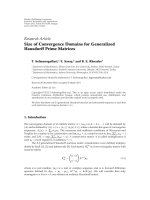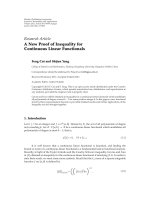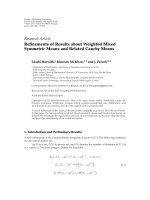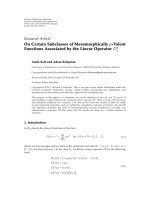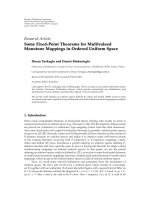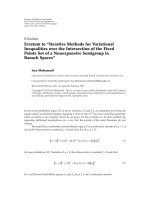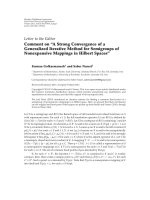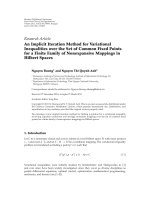Hindawi Publishing Corporation Fixed Point Theory and Applications Volume 2011, Article ID 276859, potx
Bạn đang xem bản rút gọn của tài liệu. Xem và tải ngay bản đầy đủ của tài liệu tại đây (485.28 KB, 10 trang )
Hindawi Publishing Corporation
Fixed Point Theory and Applications
Volume 2011, Article ID 276859, 10 pages
doi:10.1155/2011/276859
Research Article
An Implicit Iteration Method for Variational
Inequalities over the Set of Common Fixed Points
for a Finite Family of Nonexpansive Mappings in
Hilbert Spaces
Nguyen Buong
1
and Nguyen Thi Quynh Anh
2
1
Vietnamese Academy of Science and Technology, Institute of Information Technology, 18,
Hoang Quoc Viet, Cau Giay, Ha Noi 122100, Vietnam
2
Department of Information Technology, Thai Nguyen National University,
Thainguye 842803, Vietnam
Correspondence should be addressed to Nguyen Buong,
Received 17 December 2010; Accepted 7 March 2011
Academic Editor: Jong Kim
Copyright q 2011 N. Buong and N. T. Quynh Anh. This is an open access article distributed under
the Creative Commons Attribution License, which permits unrestricted use, distribution, and
reproduction in any medium, provided the original work is properly cited.
We introduce a new implicit iteration method for finding a solution for a variational inequality
involving Lipschitz continuous and strongly monotone mapping over the set of common fixed
points for a finite family of nonexpansive mappings on Hilbert spaces.
1. Introduction
Let C be a nonempty closed and convex subset of a real Hilbert space H with inner product
·, · and norm ·,andletF : H → H be a nonlinear mapping. The variational inequality
problem is formulated as finding a point p
∗
∈ C such that
F
p
∗
,p− p
∗
≥ 0, ∀p ∈ C. 1.1
Variational inequalities were initially studied by Kinderlehrer and Stampacchia in 1
and ever since have been widely investigated, since they cover as diverse disciplines as
partial differential equations, optimal control, optimization, mathematical programming,
mechanics, and finance see 1–3.
2 Fixed Point Theory and Applications
It is well known that if F is an L-Lipschitz continuous and η-strongly monotone, that
is, F satisfies the following conditions:
F
x
− F
y
≤ L
x − y
,
F
x
− F
y
,x− y
≥ η
x − y
2
,
1.2
where L and η are fixed positive numbers, then 1.1 has a unique solution. It is also known
that 1.1 is equivalent to the fixed-point equation
p P
C
p − μF
p
, 1.3
where P
C
denotes the metric projection from x ∈ H onto C and μ is an arbitrarily fixed
positive constant.
Let {T
i
}
N
i1
be a finite family of nonexpansive self-mappings of C. For finding an
element p ∈∩
N
i1
FixT
i
, Xu and Ori introduced in 4 the following implicit iteration process.
For x
0
∈ C and {β
k
}
∞
k1
⊂ 0, 1, the sequence {x
k
} is generated as follows:
x
1
β
1
x
0
1 − β
1
T
1
x
1
,
x
2
β
2
x
1
1 − β
2
T
2
x
2
,
.
.
.
x
N
β
N
x
N−1
1 − β
N
T
N
x
N
,
x
N1
β
N1
x
N
1 − β
N1
T
1
x
N1
,
.
.
.
1.4
The compact expression of the method is the form
x
k
β
k
x
k−1
1 − β
k
T
k
x
k
,k≥ 1, 1.5
where T
n
T
n mod N
, for integer n ≥ 1, with the mod function taking values in the set
{1, 2, ,N}. They proved the following result.
Theorem 1.1. Let H be a real Hilbert space and C a nonempty closed convex subset of H.Let{T
i
}
N
i1
be N nonexpansive self-maps of C such that ∩
N
i1
FixT
i
/
∅,whereFixT
i
{x ∈ C : T
i
x x}.Let
x
0
∈ C and {β
k
}
∞
k1
be a sequence in 0, 1 such that lim
k →∞
β
k
0. Then, the sequence {x
k
} defined
implicitly by 1.5 converges weakly to a common fixed point of the mappings {T
i
}
N
i1
.
Fixed Point Theory and Applications 3
Further, Zeng and Yao introduced in 5 the following implicit method. For an
arbitrary initial point x
0
∈ H, the sequence {x
k
}
∞
k1
is generated as follows:
x
1
β
1
x
0
1 − β
1
T
1
x
1
− λ
1
μF
T
1
x
1
,
x
2
β
2
x
1
1 − β
2
T
2
x
2
− λ
2
μF
T
2
x
2
,
.
.
.
x
N
β
N
x
N−1
1 − β
N
T
N
x
N
− λ
N
μF
T
N
x
N
,
x
N1
β
N1
x
N
1 − β
N1
T
1
x
N1
− λ
N1
μF
T
1
x
N1
,
.
.
.
1.6
The scheme is written in a compact form as
x
k
β
k
x
k−1
1 − β
k
T
k
x
k
− λ
k
μF
T
k
x
k
,k≥ 1. 1.7
They proved the following result.
Theorem 1.2. Let H be a real Hilbert space and F : H → H a mapping such that for some constants
L, η > 0, F is L-Lipschitz continuous and η-strongly monotone. Let {T
i
}
N
i1
be N nonexpansive self-
maps of H such that C ∩
N
i1
FixT
i
/
∅.Letμ ∈ 0, 2η/L
2
, and let x
0
∈ H, with {λ
k
}
∞
k1
⊂ 0, 1
and {β
k
}
∞
k1
⊂ 0, 1 satisfying the conditions:
∞
k1
λ
k
< ∞ and α ≤ β
k
≤ β, k ≥ 1,forsome
α, β ∈ 0, 1. Then, the sequence {x
k
} defined by 1.7 converges weakly to a common fixed point of
the mappings {T
i
}
N
i1
. The convergence is strong if and only if lim inf
k →∞
dx
k
,C0.
Recently, Ceng et al. 6 extended the above result to a finite family of asymptotically
self-maps.
Clearly, from
∞
k1
λ
k
< ∞ we have that λ
k
→ 0ask →∞. To obtain strong
convergence without the condition
∞
k1
λ
k
< ∞, in this paper we propose the following
implicit algorithm:
x
t
T
t
x
t
,T
t
: T
t
0
T
t
N
···T
t
1
,t∈
0, 1
, 1.8
where T
t
i
are defined by
T
t
i
x
1 − β
i
t
x β
i
t
T
i
x, i 1, ,N, T
t
0
y
I − λ
t
μF
y, x, y ∈ H, 1.9
I denotes the identity mapping of H, and the parameters {λ
t
}, {β
i
t
}⊂0, 1 for all t ∈ 0, 1
satisfy the following conditions: λ
t
→ 0ast → 0and0< lim inf
t → 0
β
i
t
≤ lim sup
t → 0
β
i
t
< 1,i
1, ,N.
4 Fixed Point Theory and Applications
2. Main Result
We formulate the following facts for the proof of our results.
Lemma 2.1 see 7. i x y
2
≤x
2
2y, x y and for any fixed t ∈ 0, 1,
ii 1 − tx ty
2
1 − tx
2
ty
2
− 1 − ttx − y
2
, for all x, y ∈ H.
Put T
λ
x Tx − λμFTx,x∈ H, λ ∈ 0, 1; for any nonexpansive mapping T of H,
we have the following lemma.
Lemma 2.2 see 8. T
λ
x − T
λ
y≤1 − λτx − y, for all x, y ∈ H and for a fixed number
μ ∈ 0, 2η/L
2
,whereτ 1 −
1 − μ2η − μL
2
∈ 0, 1.
Lemma 2.3 Demiclosedness Principle 9. Assume that T is a nonexpansive self-mapping of a
closed convex subset K of a Hibert space H.IfT has a fixed point, then I − T is demiclosed; that is,
whenever {x
k
} is a sequence in K weakly converging to s ome x ∈ K and the sequence {I − Tx
k
}
strongly converges to some y, it follows that I − Tx y.
Now, we are in a position to prove the following result.
Theorem 2.4. Let H be a real Hilbert space and F : H → H a mapping such that for some constants
L, η > 0, F is L-Lipschitz continuous and η-strongly monotone. Let {T
i
}
N
i1
be N nonexpansive self-
maps of H such that C ∩
N
i1
FixT
i
/
∅.Letμ ∈ 0, 2η/L
2
and let t ∈ 0, 1, {λ
t
}, {β
i
t
}⊂0, 1,
such that
λ
t
−→ 0, as t −→ 0, 0 < lim inf
t → 0
β
i
t
≤ lim sup
t → 0
β
i
t
< 1,i 1, ,N. 2.1
Then, the net {x
t
} defined by 1.8-1.9 converges strongly to the unique element p
∗
in 1.1.
Proof. By using Lemma 2.2 with T
λ
T
t
0
,thatis,T I, we have that
T
t
x − T
t
y
≤
1 − λ
t
τ
T
t
N
···T
t
1
x − T
t
N
···T
t
1
y
.
.
.
≤
1 − λ
t
τ
T
t
i
···T
t
1
x − T
t
i
···T
t
1
y
.
.
.
≤
1 − λ
t
τ
T
t
1
x − T
t
1
y
≤
1 − λ
t
τ
x − y
∀x, y ∈ H.
2.2
So, T
t
is a contraction in H. By Banach’s Contraction Principle, there exists a unique element
x
t
∈ H such that x
t
T
t
x
t
for all t ∈ 0, 1.
Fixed Point Theory and Applications 5
Next, we show that {x
t
} is bounded. Indeed, for a fixed point p ∈ C, we have that
T
t
i
p p for i 1, ,N, and hence
x
t
− p
T
t
x
t
− p
T
t
x
t
− T
t
N
···T
t
1
p
I − λ
t
μF
T
t
N
···T
t
1
x
t
−
I − λ
t
μF
T
t
N
···T
t
1
p − λ
t
μF
p
≤
1 − λ
t
τ
T
t
N
···T
t
1
x
t
− T
t
N
···T
t
1
p
λ
t
μ
F
p
≤
1 − λ
t
τ
T
t
N−1
···T
t
1
x
t
− T
t
N−1
···T
t
1
p
λ
t
μ
F
p
.
.
.
≤
1 − λ
t
τ
T
t
i
···T
t
1
x
t
− T
t
i
···T
t
1
p
λ
t
μ
F
p
.
.
.
≤
1 − λ
t
τ
T
t
1
x
t
− T
t
1
p
λ
t
μ
F
p
≤
1 − λ
t
τ
x
t
− p
λ
t
μ
F
p
.
2.3
Therefore,
x
t
− p
≤
μ
τ
F
p
2.4
that implies the boundedness of {x
t
}. So, are the nets {Fy
N
t
}, {y
i
t
},i 1, ,N.
Put
y
1
t
1 − β
1
t
x
t
β
1
t
T
1
x
t
,
y
2
t
1 − β
2
t
y
1
t
β
2
t
T
2
y
1
t
,
.
.
.
y
i
t
1 − β
i
t
y
i−1
t
β
i
t
T
i
y
i−1
t
,
.
.
.
y
N
t
1 − β
N
t
y
N−1
t
β
N
t
T
N
y
N−1
t
.
2.5
Then,
x
t
I − λ
t
μF
y
N
t
. 2.6
6 Fixed Point Theory and Applications
Moreover,
x
t
− p
2
I − λ
t
μF
y
N
t
− p
2
y
N
t
− p
2
− 2λ
t
μ
F
y
N
t
,y
N
t
− p
λ
2
t
μ
2
F
y
N
t
2
≤
y
N−1
t
− p
2
− 2λ
t
μ
F
y
N
t
,y
N
t
− p
λ
2
t
μ
2
F
y
N
t
2
.
.
.
≤
y
1
t
− p
2
− 2λ
t
μ
F
y
N
t
,y
N
t
− p
λ
2
t
μ
2
F
y
N
t
2
≤
x
t
− p
2
− 2λ
t
μ
F
y
N
t
,y
N
t
− p
λ
2
t
μ
2
F
y
N
t
2
.
2.7
Thus,
η
y
N
t
− p
2
F
p
,y
N
t
− p
≤
λ
t
μ
2
F
y
N
t
2
. 2.8
Further, for the sake of simplicity, we put y
0
t
x
t
and prove that
y
i−1
t
− T
i
y
i−1
t
−→ 0, 2.9
as t → 0fori 1, ,N.
Let {t
k
}⊂0, 1 be an arbitrary sequence converging to zero as k →∞and x
k
: x
t
k
.
We have to prove that y
i−1
k
− T
i
y
i−1
k
→0, where y
i
k
are defined by 2.5 with t t
k
and
y
i
k
y
i
t
k
.Let{x
l
} be a subsequence of {x
k
} such that
lim sup
k →∞
y
i−1
k
− T
i
y
i−1
k
lim
l →∞
y
i−1
l
− T
i
y
i−1
l
. 2.10
Let {x
k
j
} be a subsequence of {x
l
} such that
lim sup
k →∞
x
k
− p
lim
j →∞
x
k
j
− p
. 2.11
Fixed Point Theory and Applications 7
From 2.6 and Lemma 2.1, it implies that
x
k
j
− p
2
I − λ
k
j
μF
y
N
k
j
− p
2
≤
y
N
k
j
− p
2
− 2λ
k
j
μ
F
y
N
k
j
,x
k
j
− p
1 − β
N
k
j
y
N−1
k
j
− p
β
N
k
j
T
N
y
N−1
k
j
− T
N
p
2
− 2λ
k
j
μ
F
y
N
k
j
,x
k
j
− p
≤
1 − β
N
k
j
y
N−1
k
j
− p
2
β
N
k
j
T
N
y
N−1
k
j
− T
N
p
2
− 2λ
k
j
μ
F
y
N
k
j
,x
k
j
− p
≤
y
N−1
k
j
− p
2
− 2λ
k
j
μ
F
y
N
k
j
,x
k
j
− p
≤···≤
y
1
k
j
− p
2
− 2λ
k
j
μ
F
y
N
k
j
,x
k
j
− p
≤
x
k
j
− p
2
− 2λ
k
j
μ
F
y
N
k
j
,x
k
j
− p
.
2.12
Hence,
lim
j →∞
x
k
j
− p
lim
j →∞
y
i
k
j
− p
,i 1, ,N. 2.13
By Lemma 2.1,
y
i
k
j
− p
2
1 − β
i
k
j
y
i−1
k
j
− p
2
β
i
k
j
T
i
y
i−1
k
j
− p
2
− β
i
k
j
1 − β
i
k
j
y
i−1
k
j
− T
i
y
i−1
k
j
2
≤
1 − β
i
k
j
y
i−1
k
j
− p
2
β
i
k
j
y
i−1
k
j
− p
2
− β
i
k
j
1 − β
i
k
j
y
i−1
k
j
− T
i
y
i−1
k
j
2
y
i−1
k
j
− p
2
− β
i
k
j
1 − β
i
k
j
y
i−1
k
j
− T
i
y
i−1
k
j
2
≤···
y
0
k
j
− p
2
− β
i
k
j
1 − β
i
k
j
y
i−1
k
j
− T
i
y
i−1
k
j
2
x
k
j
− p
2
− β
i
k
j
1 − β
i
k
j
y
i−1
k
j
− T
i
y
i−1
k
j
2
,i 1, ,N.
2.14
8 Fixed Point Theory and Applications
Without loss of generality, we can assume that α ≤ β
i
t
≤ β for some α, β ∈ 0, 1. Then, we have
α
1 − β
y
i−1
k
j
− T
i
y
i−1
k
j
2
≤
x
k
j
− p
2
−
y
i
k
j
− p
2
. 2.15
This together with 2.13 implies that
lim
j →∞
y
i−1
k
j
− T
i
y
i−1
k
j
2
0,i 1, ,N. 2.16
It means that y
i−1
t
− T
i
y
i−1
t
→0ast → 0fori 1, ,N.
Next, we show that x
t
− T
i
x
t
→0ast → 0. In fact, in the case that i 1 we have
y
0
t
x
t
.So,x
t
− T
1
x
t
→0ast → 0. Further, since
y
1
t
− T
1
x
t
1 − β
1
t
x
t
− T
1
x
t
, 2.17
and x
t
− T
1
x
t
→0, we have that y
1
t
− T
1
x
t
→0. Therefore, from
x
t
− y
1
t
≤
x
t
− T
1
x
t
T
1
x
t
− y
1
t
, 2.18
it follows that x
t
− y
1
t
→0ast → 0. On the other hand, since
y
2
t
− T
2
y
1
t
1 − β
2
t
y
1
t
− T
2
y
1
t
−→ 0,
y
2
t
− x
t
≤
1 − β
2
t
y
1
t
− x
t
β
2
t
T
2
y
1
t
− x
t
≤
1 − β
2
t
y
1
t
− x
t
β
2
t
T
2
y
1
t
− y
1
t
y
1
t
− x
t
,
2.19
we obtain that y
2
t
− x
t
→0ast → 0. Now, from
x
t
− T
2
x
t
≤
x
t
− y
2
t
y
2
t
− T
2
y
1
t
T
2
y
1
t
− T
2
x
t
≤
x
t
− y
2
t
y
2
t
− T
2
y
1
t
y
1
t
− x
t
,
2.20
and x
t
− y
2
t
, y
2
t
− T
2
y
1
t
, y
1
t
− x
t
→0, it follows that x
t
− T
2
x
t
→0. Similarly, we obtain
that x
t
− T
i
x
t
→0, for i 1, ,N and y
N
t
− x
t
→0ast → 0.
Let {x
k
} be any sequence of {x
t
} converging weakly to p as k →∞. Then, x
k
−
T
i
x
k
→0, for i 1, ,N and {y
N
k
} also converges weakly to p.ByLemma 2.3, we have
p ∈ C ∩
N
i1
FixT
i
and from 2.8, it follows that
F
p
,p− p
≥ 0 ∀p ∈ C. 2.21
Fixed Point Theory and Applications 9
Since p, p ∈ C, by replacing p by tp 1 − tp in the last inequality, dividing by t and taking
t → 0 in the just obtained inequality, we obtain
F
p
,p− p
≥ 0 ∀p ∈ C. 2.22
The uniqueness of p
∗
in 1.1 guarantees that p p
∗
. Again, replacing p in 2.8 by p
∗
,we
obtain the strong convergence for {x
t
}. This completes the proof.
3. Application
Recall that a mapping S : H → H is called a γ-strictly pseudocontractive if there exists a
constant γ ∈ 0, 1 such that
Sx − Sy
2
≤
x − y
2
γ
I − S
x −
I − S
y
2
, ∀x, y ∈ H. 3.1
It is well known 10 that a mapping T : H → H by Tx αx 1−αSx with a fixed α ∈ γ,1
for all x ∈ H is a nonexpansive mapping and FixTFixS. Using this fact, we can extend
our result to the case C ∩
N
i1
FixS
i
, where S
i
is γ
i
-strictly pseudocontractive as follows.
Let α
i
∈ γ
i
, 1 be fixed numbers. Then, C ∩
N
i1
Fix
T
i
with
T
i
y α
i
y 1 − α
i
S
i
y,a
nonexpansive mapping, for i 1, ,N, and hence
T
t
i
y
1 − β
i
t
y β
i
t
T
i
y
1 − β
i
t
1 − α
i
y β
i
t
1 − α
i
S
i
y, i 1, ,N.
3.2
So, we have the following result.
Theorem 3.1. Let H be a real Hilbert space and F : H → H a mapping such that for some
constants L, η > 0, F is L-Lipschitz continuous and η-strongly monotone. Let {S
i
}
N
i1
be Nγ
i
-strictly
pseudocontractive self-maps of H such that C ∩
N
i1
FixS
i
/
∅.Letα
i
∈ γ
i
, 1,μ∈ 0, 2η/L
2
and
let t ∈ 0, 1, {λ
t
}, {β
i
t
}⊂0, 1, such that
λ
t
−→ 0, as t −→ 0, 0 < lim inf
t → 0
β
i
t
≤ lim sup
t → 0
β
i
t
< 1,i 1, ,N. 3.3
Then, the net {x
t
} defined by
x
t
T
t
x
t
,
T
t
: T
t
0
T
t
N
···
T
t
1
,t∈
0, 1
, 3.4
where
T
t
i
,fori 1, ,N, are defined by 3.2 and T
t
0
x I − λ
t
μFx, converges strongly to the
unique element p
∗
in 1.1.
It is known in 11 that Fix
SC where
S
N
i1
ξ
i
S
i
with ξ
i
> 0and
N
i1
ξ
i
1
for Nγ
i
-strictly pseudocontractions {S
i
}
N
i1
. Moreover,
S is γ-strictly pseudocontractive with
γ max{γ
i
:1≤ i ≤ N}. So, we also have the following result.
10 Fixed Point Theory and Applications
Theorem 3.2. Let H be a real Hilbert space and F : H → H a mapping such that for some
constants L, η > 0, F is L-Lipschitz continuous and η-strongly monotone. Let {S
i
}
N
i1
be Nγ
i
-
strictly pseudocontractive self-maps of H such that C ∩
N
i1
FixS
i
/
∅.Letα ∈ γ,1,where
γ max{γ
i
:1≤ i ≤ N}, μ ∈ 0, 2η/L
2
, and let t ∈ 0, 1, {λ
t
}, {β
t
}⊂0, 1, such that
λ
t
−→ 0, as t −→ 0, 0 < lim inf
t → 0
β
t
≤ lim sup
t → 0
β
t
< 1. 3.5
Then, the net {x
t
}, defined by
x
t
T
t
x
t
,
T
t
: T
t
0
1 − β
t
1 − α
I β
t
1 − α
N
i1
ξ
i
S
i
,t∈
0, 1
, 3.6
where T
t
0
I − λ
t
μF, ξ
i
> 0, and
N
i1
ξ
i
1, converges strongly to the unique element p
∗
in 1.1.
Acknowledgment
This work was supported by the Vietnamese National Foundation of Science and Technology
Development.
References
1 D. Kinderlehrer and G. Stampacchia, An Introduction to Variational Inequalities and Their Applications,
vol. 88 of Pure and Applied Mathematics, Academic Press, New York, NY, USA, 1980.
2 R. Glowinski, Numerical Methods for Nonlinear Variational Problems, Springer Series in Computational
Physics, Springer, New York, NY, USA, 1984.
3 E. Zeidler, Nonlinear Functional Analysis and Its Applications. III, Springer, New York, NY, USA, 1985.
4 H K. Xu and R. G. Ori, “An implicit iteration process for nonexpansive mappings,” Numerical
Functional Analysis and Optimization, vol. 22, no. 5-6, pp. 767–773, 2001.
5 L C. Zeng and J C. Yao, “Implicit iteration scheme with perturbed mapping for common fixed points
of a finite family of nonexpansive mappings,” Nonlinear Analysis. Theory, Methods & Applications, vol.
64, no. 11, pp. 2507–2515, 2006.
6 L C. Ceng, N C. Wong, and J C. Yao, “Fixed point solutions of variational inequalities for a
finite family of asymptotically nonexpansive mappings without common fixed point assumption,”
Computers & Mathematics with Applications, vol. 56, no. 9, pp. 2312–2322, 2008.
7 G. Marino and H K. Xu, “Weak and strong convergence theorems for strict pseudo-contractions in
Hilbert spaces,” Journal of Mathematical Analysis and Applications, vol. 329, no. 1, pp. 336–346, 2007.
8 Y. Yamada, “The hybrid steepest-descent method for variational inequalities problems over the
intesectionof the fixed point sets of nonexpansive mappings,” in Inhently Parallel Algorithms in
Feasibility and Optimization and Their Applications, D. Butnariu, Y. Censor, and S. Reich, Eds., pp. 473–
504, North-Holland, Amsterdam, Holland, 2001.
9 K. Goebel and W. A. Kirk, Topics in Metric Fixed Point Theory, vol. 28 of Cambridge Studies in Advanced
Mathematics, Cambridge University Press, Cambridge, UK, 1990.
10 H. Zhou, “Convergence theorems of fixed points for κ-strict pseudo-contractions in Hilbert spaces,”
Nonlinear Analysis. Theory, Methods & Applications, vol. 69, no. 2, pp. 456–462, 2008.
11 G. L. Acedo and H K. Xu, “Iterative methods for strict pseudo-contractions in Hilbert spaces,”
Nonlinear Analysis. Theory, Methods & Applications, vol. 67, no. 7, pp. 2258–2271, 2007.
